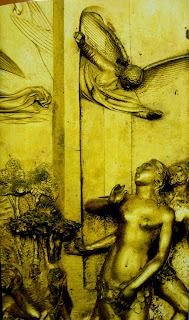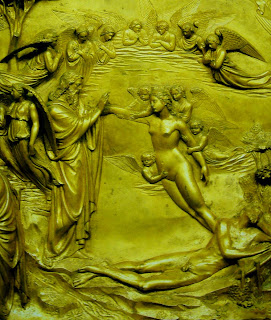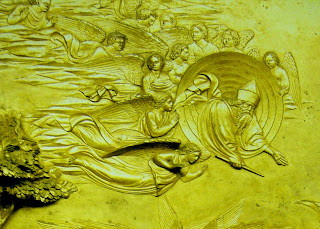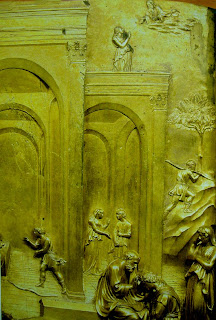
Hallelujah !
Ghiberti's "Gates of Paradise"
made it to Chicago
(or... at least 3 panels will be on display
here until October14th)

First - to dispense with the complaints department:
1. Museums should never prohibit the public from taking photographs of historical work
2. Reproductions of these doors used to be, and still should be, on permanent display at the Chicago museum - just as they are today on the wall where the originals used to hang.
(because there is no way that photographs can do justice -- to even the areas in lowest relief)
2. Reproductions of these doors used to be, and still should be, on permanent display at the Chicago museum - just as they are today on the wall where the originals used to hang.
(because there is no way that photographs can do justice -- to even the areas in lowest relief)

But complaints aside -- wow !
what a sculptural project.
Did it really take Ghiberti,
and a crew that included Donatello and Uccello,
20 years to complete this project ?
When you consider both the power and the detail of
the design -- yes I can believe it.
(above is my favorite panel from the show, "Genesis")

Contrarian that he is,
my father
insists that the worst sculptor
won the contest for the Baptistery doors
(he says Ghiberti is "too fussy"
and he's a big fan of
the more macho Della Quercia -
and looking at this piece , I could almost agree
(it always sends shivers down my spine)
But please !
let's give Lorenzo a break -
it was a far different sculptor who made these doors
from the one who won the contest.
(above is a second panel from the show, "David")
 One of the big issues
One of the big issuesthat's worried me ...
is what is the proper angle from which
each panel should be viewed.
"Genesis" originally was way at the top, 8-10 feet up on wall
while "David" would have been somewhere around the knees.
In the Chicago exhibit -- they're all hung at eye level
and after visiting them about 6 times so far,
I've finally concluded that was the best plan,
since my choice of an ideal viewpoint,
for ALL three,
is about a foot lower than my eyes
(and I'm six foot)
(and come to think of it ...
that's smack in the center of each panel ,
and would correspond to the vanishing point on the above scene)
So .. I really don't think Lorenzo was planning for
the angle of sight
that would be available
when the panels got hung up on the door.
The doors seem to compose well with each other
in their current positions,
but I think the viewer was meant to kneel to see the bottom panels,
and stand up on a chair to see the top ones.
(above is the third panel now in Chicago, "Isaac")

But getting around to the details ---
(which is why this exhibit is so special)
Here's Eve from the "Genesis" panel.
And.. I'm afraid I'm starting to have a problem with it --
not just this detail,
but all of the areas in high-relief,
like this figure of Eve.
The full-round figures just don't satisfy me
anywhere near the pleasure I get
from the design as a whole.
(a design that gives such a wonderful impact
to that angel flying through the original
"gates of Paradise"

What I noticed about Adam in the Creation,
on this, my sixth visit,
is that he's so pathetic.

Here, he's a like a drunk being helped up from the pavement,
and in the previous scene,
he's shown hiding behind Eve,
as the angel drives them out of the Garden

Eve, on the hand, is transcendent,
here -- as she rises up from the sleeping Adam

..and here as she protects
her helpless mate.
Was Ghiberti a mama's boy ?
Look again at the entire scene:

Woman is the crown of creation.

On my first few trips,
it was little, low relief details like this

..and this
that really charmed me
(and I've always liked angels)
But this time,
I think it's over-all drama,
and sense of pictorial space
that were really his specialty.
(maybe he should have been a painter)
 Moving on to the story of Jacob & Esau,
Moving on to the story of Jacob & Esau,I admit to being a little confused
by all this court trickery.
But I guess Isaac was confused too,
so the feeling is appropriate.

What are those figures doing in the background ?
Mischief is afoot - and I don't like it

A collection of unbalanced fools and
scheming cheats,
how unpleasant !


Elegance and treachery.
(Machiavelli lived about a century later)
(I think the boys in the background
are Esau selling his birthright to Jacob
for a mess of porridge)

I fail to see the purpose for these figures on the left,
other than to make a visual design
with the rest of the panel and doors
or, perhaps, to give that feeling of conspiracy,
as they whisper together
backs to the audience
(note: my friend Misha has given me a more positive,rabbinical interpretation:
God knows that Esau, poor boy, is unfit to transfer the Jewish tradition
(he had already sold his birthright for a meal)
so God, Isaac, Jacob, and Rebeccah are all in on the scheme
to take Esau out of the picture)



And finally, moving on to my favorite,
the story of David and Goliath

It's not really that the overall design
stands out among the others,
but the details on the figures
seem to have been done by someone
better than whoever finished up the other two.
Wherever the eyes closes in on a detail,
it is well rewarded !
There's just an incredible intensity about
the areas in low relief.

like this plane of receding soldiers.
(the photo really is not doing it justice)
 and this wonderful little scene
and this wonderful little scene
that appears in the distance,
the entrance into Jerusalem
carrying the head of Goliath.
It's like a world within a world,
and the energy
never
slackens




every little head in the background,
perfect - with its own expression
*************************
(below is the Han Dynasty figure from the Met
to which Lori referred in her comment)




And finally, moving on to my favorite,
the story of David and Goliath

It's not really that the overall design
stands out among the others,
but the details on the figures
seem to have been done by someone
better than whoever finished up the other two.
Wherever the eyes closes in on a detail,
it is well rewarded !
There's just an incredible intensity about
the areas in low relief.

like this plane of receding soldiers.
(the photo really is not doing it justice)
 and this wonderful little scene
and this wonderful little scenethat appears in the distance,
the entrance into Jerusalem
carrying the head of Goliath.
It's like a world within a world,
and the energy
never
slackens




every little head in the background,
perfect - with its own expression
*************************
(below is the Han Dynasty figure from the Met
to which Lori referred in her comment)

In Firenze, I lose interest in the high-relief figures up-close. The composition of each panel draws me in and disappoints me in some figurative details...I find myself marveling over any architectural relief bits rather than the limbs of the alto figures.
ReplyDeleteI'm so glad you have a Chicago viewing!
Hi there, Chris
ReplyDelete& Amanda as well--
It's always interesting to see you two (where's Robert?) mulling over an older work. I suppose that if you had been Ghiberti's contemporaries, you would have been more impressed, since it is impossible for the future to be impressed by the past's break from an earlier past.
One thing I like about this sort of sacred work is the way that it exists in eternal time, with a God's-eye view that says all things can be seen at once. The freshness of a new thing in the world, newborn beauty, the tempter's words, and the explusion are all happening--and Adam's sleep that gives way to the removed rib and the birth of Eve can therefore declare that out of the pierced side of God's son will come the redemption of an allegorical bride, the church. I imagine that a contemporary of Ghiberti would see both things simultaneously. The funny thing is that we're stuck in our time and can't see all this complexity without poring over the panels and thinking. But I imagine all that richness of story and typology just poured out for an earlier viewer.
You're absolutely right, Marly, -- this piece is not about figurative details -- it's about a powerful, sacred vision of man's place in the universe.
ReplyDeleteI might sometimes lose sight of that because usually, when I'm looking at a sculpture, I'm asking "what am I going to do next?" -- and the answer usually involves pushing around a little lump of clay.
And I guess I'd better confess -- sometimes these sacred visions are just too powerful for me - and I find more comfort meandering among the details.
I like your meanderings in the details...
ReplyDeleteBut it is a challenge to the current day, isn't it? How does one make something that has that degree of richness and "bigness" in our time? How does one create a work of art that will be worth talking about when almost 600 years have passed?
Late on the scene today, bit busy!
ReplyDeleteThanks for taking the photos Chris and for the focus on this work, which is new to me.
I will be back with further comment after further viewing!
These gates...so much loveliness. Chris, thanks for sharing them. (BTW, I hope my turn as a crazy woman midway through Slacker made you laugh, rather than say "Oh. My. WTF?!")
ReplyDelete"...worth talking about when 600 years have passed..."
Great Q, Marly!
My $0.02:
Some of what makes for the talk is technique, something difficult made to seem graceful and simple, something complex that makes us gasp.
Some of what makes for the talk is some sort of opening or connection between the maker's world and ours, between the maker and the viewer.
What did an ancient Han sculpture "mean" to those who made it, to those who commissioned or bought it?
http://www.metmuseum.org/special/
Sichuan/110.r.htm
What does it "mean" to us, many years and many cultural divides later?
Walked by these in the wee hours of this morning and wished you could take my place.
ReplyDeleteAmanda: it's good to hear you're back in Florence (and I wish I could have taken your place as well)
ReplyDeleteMarly: The Gates can be used to exemplify our western, pre-modern civilization, can't they ? I think that's why they so talkable about.
Lori: I've posted the picture of that dancing Han musician from the Met.
Quite an exuberant piece !
Wasn't that stuff created for tombs? To keep the dead entertained (so they wouldn't be out making trouble) ?
(note: I'm still adding to the post - and will probably continue until the pieces go back to Florence)
Thank you, Chris. These close up photos show me what i somehow missed looking at them in situ. Of course, when one is in Florence one is continuously so distracted. Plus, I suppose, I found it difficult to look at monochrome statuary with all those colorful frescoes and temperas and mosaics around!
ReplyDeleteI do love these gates, and they are worthy of more study.
ReplyDelete